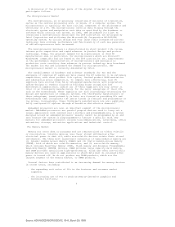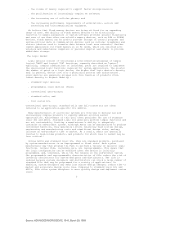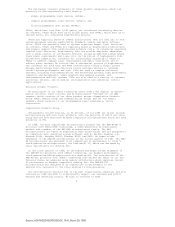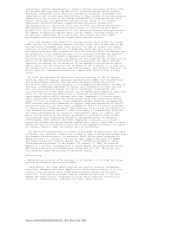AMD 1998 Annual Report Download - page 17
Download and view the complete annual report
Please find page 17 of the 1998 AMD annual report below. You can navigate through the pages in the report by either clicking on the pages listed below, or by using the keyword search tool below to find specific information within the annual report.Environmental Regulations
We could possibly be subject to fines, suspension of production, alteration
of our manufacturing processes or cessation of our operations if we fail to
comply with present or future governmental regulations related to the use,
storage, handling, discharge or disposal of toxic, volatile or otherwise
hazardous chemicals used in the manufacturing process. Such regulations could
require us to acquire expensive remediation equipment or to incur other
expenses to comply with environmental regulations. Our failure to control the
use, disposal or storage of, or adequately restrict the discharge of,
hazardous substances could subject us to future liabilities and could have a
material adverse effect on our business.
Intellectual Property and Licensing
We have been granted over 2,014 United States patents, and over 2,848 patent
applications are pending in the United States. In certain cases, we have filed
corresponding applications in foreign jurisdictions. We expect to file future
patent applications in both the United States and abroad on significant
inventions as we deem appropriate.
In January of 1995, we reached an agreement with Intel to settle all
previously outstanding legal disputes between the two companies. As part of
the settlement, in December 1995, we signed a five-year, comprehensive cross-
license agreement with Intel which expires on December 31, 2000. The agreement
provides that after December 20, 1999, the parties will negotiate in good
faith a patent cross-license agreement to be effective on January 1, 2001. The
existing cross-license agreement gives AMD and Intel the right to use each
others' patents and certain copyrights, including copyrights to the x86
instruction sets but excluding other microprocessor microcode copyrights. The
cross-license is royalty-bearing for our products that use certain Intel
technologies. We are required to pay Intel minimum non-refundable royalties
during the years 1997 through 2000.
In addition, we have entered into numerous cross-licensing and technology
exchange agreements with other companies under which they both transfer and
receive technology and intellectual property rights. Although we attempt to
protect our intellectual property rights through patents, copyrights, trade
secrets and other measures, we cannot give any assurance that we will be able
to protect our technology or other intellectual property adequately or that
competitors will not be able to develop similar technology independently. We
cannot give any assurance that any patent applications that we may file will
be issued or that foreign intellectual property laws will protect our
intellectual property rights. We cannot give any assurance that any patent
licensed by or issued to us will not be challenged, invalidated or
circumvented, or that the rights granted thereunder will provide competitive
advantages to us. Furthermore, we cannot give any assurance that others will
not independently develop similar products, duplicate our products or design
around our patents and other rights.
From time to time, we have been notified that we may be infringing
intellectual property rights of others. If any claims are asserted against us,
we may seek to obtain a license under the third party's intellectual property
rights. We could decide, in the alternative, to resort to litigation to
challenge these claims. These challenges could be extremely expensive and
time-consuming and could materially and adversely affect us. We cannot give
any assurance that all necessary licenses can be obtained on satisfactory
terms, or that litigation may always be avoided or successfully concluded.
Backlog
We manufacture and market standard lines of products. Consequently, a
significant portion of our sales are made from inventory on a current basis.
Sales are made primarily pursuant to purchase orders for current delivery, or
agreements covering purchases over a period of time, which are frequently
subject to revision and cancellation without penalty. Generally, in light of
current industry practice and experience, we do not believe that such
agreements provide meaningful backlog figures or are necessarily indicative of
actual sales for any succeeding period.
Employees
On January 24, 1999, we employed approximately 13,800 employees, none of
whom are represented by collective bargaining arrangements. We believe that
our relationship with our employees is generally good.
14
Source: ADVANCED MICRO DEVIC, 10-K, March 29, 1999
























